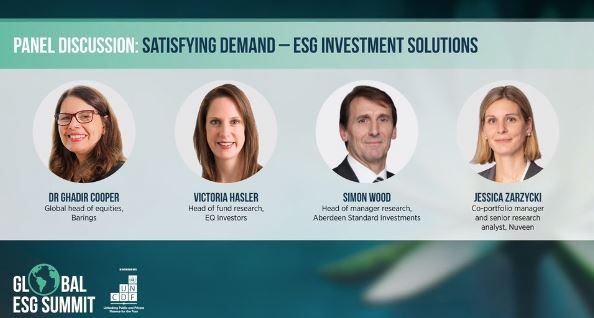Despite an influx in new ESG fund launches, there still may not be enough – particularly in the fixed income, alternatives and emerging market spaces – for selectors to have a sufficient level of choice for portfolios.
This was one of the findings of the third panel from the UK/EU stream of the Global ESG Summit. The panel, titled Satisfying demand – ESG investment solutions, saw Victoria Hasler, head of fund research at EQ Investors and Simon Wood, head of manager research at Aberdeen Standard Investments, say these are areas they still find challenging.
On social bonds in particular, Hasler said: “The slight issue is it’s still a really small market. For us, the fact the green bond market is growing is amazing, the fact social bonds are growing is brilliant, but you can’t necessarily build a portfolio out of those. We still need other solutions in different parts of our portfolios. For example, one issue we have with green bonds is most of the issuance is medium-dated, there’s not much at the short-dated end and if you don’t want duration in your portfolio, that’s a challenge. There’s very little out there.”
Jessica Zarzycki, co-portfolio manager and senior research analyst at Nuveen, agreed social issuance has slowed in 2021, but she added: “What’s good about fixed income is we get annual updates on the projects and we can directly translate this to our clients, I think this is unique compared with the equity market. It’s also a great way to see the steps and checks towards 2030 and 2050 goals.”
Maintaining the credibility of the green and social bonds market is key for Zarzycki, ensuring greenwashing is kept at bay.
Passives
The panel also discussed the role passives have to play in the ESG space. “There’s no excuse for passives not to play a huge role here. If we’re using passives we use sustainable passives,” said Wood.
Hasler agreed. “We also use sustainable passives, there are more launching that track sustainable indexes, I think they can be really useful – you do have to be aware of the limitations of the methodologies and particularly the data they are using, those are usually quite backward-looking.
“The big passive players control so much capital and some are trying to vote in a positive way, but if they really got behind that and did it in a really active way I think it could be a gamechanger. But the thing to note is most people buy passives for the price and the more active engagement they do the more you can expect it to push the price up.”
Engagement and voting are clearly key and Zarzycki said Nuveen picks two to three topics per year to focus on proxy voting.
But Dr Ghadir Cooper, global head of equities at Barings, said this is an area passives could potentially fall short. “When we engage we’re doing two things – trying to get more data, which is good for the whole world, and trying to get them to change their behaviour, which requires knowing the company intimately, rather than owning it collectively in a passive way. I think it’s an advantage active managers have over passive. There is also collective engagement on the active side – Climate Action 100+ for example.”
Ultimately, the key for Wood will be to maintain pressure – selectors on managers, and the managers on the companies in which they invest. This, coupled with practicing what they preach, and increasing the knowledge of ESG in the industry as a whole, are what the panel said will see the area go from strength to strength.
The full UK/Europe-based can be viewed after free registration. The US-based and the Asia-focused event event also are available on demand.








